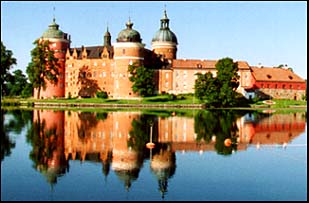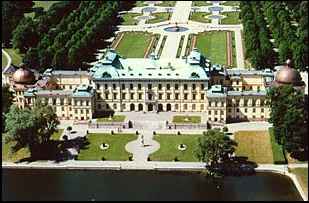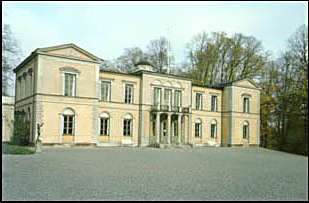 The Kingdom of Sweden
The Kingdom of Sweden 
Sweden was
a part of the Danish Kingdom between 1397 and 1523.
Gripsholm

Gripsholm
Slott was built in
the 14th century for the Swedish governor Bo Jonsson Grip. Two centuries later
it was rebuilt as a royal residence for King Gustaf I Wasa. Some kings as Erik
XIV, Johan III and Gustaf IV Adolf were kept as prisoners here. Now the castle
is a museum with paintings, works of art, furniture, two Russian cannons and a
theatre. The castle is surrounded by water. In the park are two
rune-stones.
Helsingborg
Kärnan used to be a 14th century
fortress, but was demolished in 1857. It was built by King Erik of Pomerania so
he could dominate the toll collection on the Sont. Left of the fortress is the
25m high tower in the park. In there is an exhibition on the history of the
fortress. From the tower you have a beautiful view.
Sofiero is a little ivy-grown castle built
as a summer residence for the later King Oscar II in 1865. The garden with
statues has the biggest European rhododendron nursery.
Kalmar
The renaissance castle
Kalmar was built for the kings Johann II and Erik XIV. It has five
towers, walls and a castle-moat. Some rooms are to view and the chapel. Kalmar
was the place where Queen Margrethe I signed the Union of Kalmar which united
Denmark, Sweden and Norway in 1397.
Örbyhus
The Örbyhus Slott from
the Middle Ages got his present outlook under the kings Gustaf I and Erik XIV.
Erik XIV was held prisoner in here by his brothers and died here in 1577,
possibly poisoned.
Örebro
Örebro Slott was built in
the 12th and the 13th century, and enlarged by King Magnus Eriksson in the 14th
century and by King Karl IX in the 16th century in renaissance style. King
Gustaf II Adolf was crowned here, and the French Jean Baptiste Bernadotte was
here chosen as the heir to the throne in 1810 (he later became King Karl XIV
Johan). A castle-moat and a park surround the castle. It is the residence of the
governor of the province, but it is to visit. Outside is a statue of King Karl
XIV Johan.
Solliden,
Öland
Solliden is an Italian renaissance
palace built in 1906 as a summer residence for the Swedish Queen Victoria. Now
it is the summer residence of King Carl XVI Gustaf and his family. When he is
not here, you can pay a visit to the palace.
Stockholm was founded in 1252.

Drottningholm
Slott, the
Versailles of Sweden, was built between 1662 and 1700 in French style for Queen
Hedwig Eleonora. It is still a royal residence, but is to visit when the royal
family is not at home. The magnificent garden lodges a theatre museum from 1766,
a Chinese palace from 1769 with the Chinese puppet theatre of King Gustaf
III.

King Gustav III's
Pavilion.
Haga Slott is the place where King Carl XVI Gustaf was born.
It was built between 1802 and 1804 and modernized in 1932. Now it is used for
representations. The English garden has some pavilions and a butterfly-garden.
On an island in the Hagaparken is a royal cemetery where amongst others the
grandparents and the father of the present king are
buried.

The Kungeliga Slott
was built between 1690 and 1750 on the fundaments of the 13th century castle Tre
Kronor (burned down in 1697). It was built in combined Italian renaissance,
baroque and French classical styles. The royal family uses it as working and
reception residence. The 600 rooms and halls contain many treasures: porcelain,
statues, gobelins, the royal orders of knighthood and the Swedish thrones and
regalia. There is also a chapel. The changing of the guards, with band, takes
place between June and August at 12:50pm.
The
Riddarholmskyrkanhas fundaments from about 1270. It was then a part of a
Franciscan monastery. It was partly rebuilt in the 15th and the 16th century.
Since the 17th century many Swedish kings and queens are buried here. There are
some baroque tombs.

Rosendals Slott, on
Djurgården Island, was built between 1823 and 1827 as summer residence of King
Karl XIV Johan. Now it is a museum furnished in 18th and 19th century French
Empire style.
The Stadshuset,
Stockholm’s town hall, was built in 1923. Here the Noble prizes are presented.
It has a 106m high bell-tower with on its side the tomb of Birger Jarl, a
Swedish regent. Interesting are the council-hall, the statues, paintings,
colonnades and the golden hall for banquets. Prince Eugen made some wall
paintings.
The Storkyrkan is a
13th century cathedral, consecrated in 1306. It was enlarged in the 15th
century. Inside is a royal box. This is the cathedral where some Wasa-kings and
all Bernadotte-kings were crowned.
Prince Eugen's
Waldemarsudde, on the Djurgården Island, was built between 1903 and 1905
for prince Eugen (1865-1947), who was a painter. Since 1913 the house is an art
gallery also. Prince Eugen left his work and his art collection to the Swedish
state. They show his inheritance here.
· Välkommen till Waldemarsudde
Strängnäs
In the 13th century Domkirke, built
in gothic style, are the tombs of the Swedish governor Sven Sture and King Karl
IX with both his wives. The church has a rich interior with
frescoes.
Uppsala
The Dom is the most
important cathedral of Sweden. The church of 1154 was rebuilt in gothic style
between 1270 and 1435. The two towers are 120m high. There are four rune-stones
in the cathedral. Here also the Kings Gustaf I and Johann III are buried in
chapels.
The Slott is the
castle of the royal Wasa-family. It lies on a hill with a great view on the
town. It was built under King Gustaf I since 1549, but never entirely finished.
It partly burned down in 1702. Inside is an art museum, and also the hall where
King Gustaf I was crowned and where Queen Christina abdicated in 1654. Now the
castle is a government seat, but it is partly open for the public. In front of
it is a bust of King Gustaf I.
Vadstena
The Blåkyrkan is an abbey
church, consecrated in 1430, and built of blue limestone. It contains the relics
of Swedish national saint Birgitta and some church art. Here is also the tomb of
prince Magnus, the youngest son of King Gustaf I.
The renaissance castle
Vättersborg was built for King Gustaf I and his sons between 1545 and
1620.It has a wide castle-moat, some towers and gates, and a gothic chapel. It
was restored in the 19th century and now houses the state
archives.
Västerås
The 13th century
Cathedral has a 103m high tower. Inside are some church treasures and the
tomb of King Erik XIV.